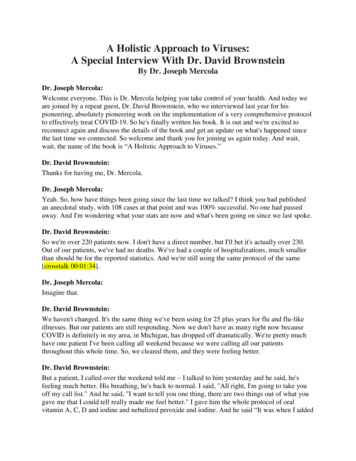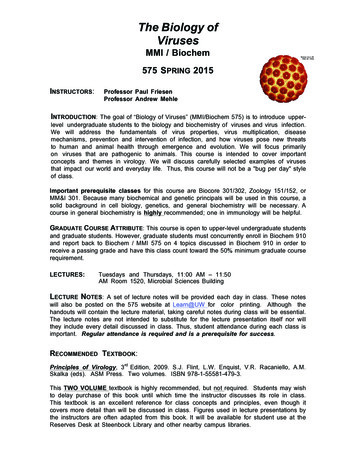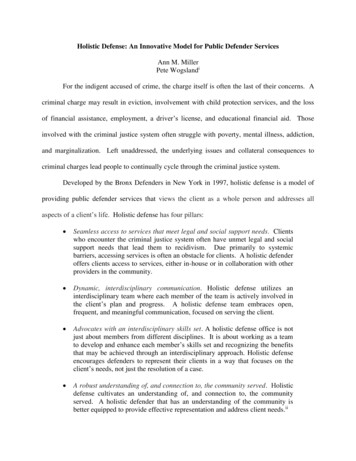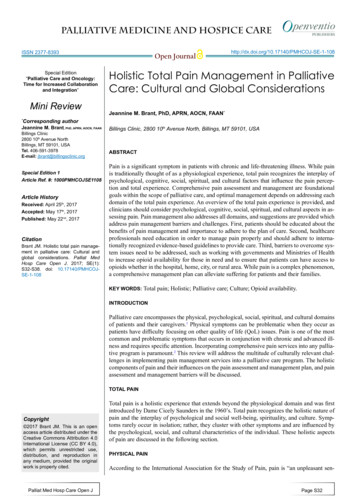
Transcription
A Holistic Approach to Viruses:A Special Interview With Dr. David BrownsteinBy Dr. Joseph MercolaDr. Joseph Mercola:Welcome everyone. This is Dr. Mercola helping you take control of your health. And today weare joined by a repeat guest, Dr. David Brownstein, who we interviewed last year for hispioneering, absolutely pioneering work on the implementation of a very comprehensive protocolto effectively treat COVID-19. So he's finally written his book. It is out and we're excited toreconnect again and discuss the details of the book and get an update on what's happened sincethe last time we connected. So welcome and thank you for joining us again today. And wait,wait, the name of the book is “A Holistic Approach to Viruses.”Dr. David Brownstein:Thanks for having me, Dr. Mercola.Dr. Joseph Mercola:Yeah. So, how have things been going since the last time we talked? I think you had publishedan anecdotal study, with 108 cases at that point and was 100% successful. No one had passedaway. And I'm wondering what your stats are now and what's been going on since we last spoke.Dr. David Brownstein:So we're over 220 patients now. I don't have a direct number, but I'll bet it's actually over 230.Out of our patients, we've had no deaths. We've had a couple of hospitalizations, much smallerthan should be for the reported statistics. And we're still using the same protocol of the same[crosstalk 00:01:34].Dr. Joseph Mercola:Imagine that.Dr. David Brownstein:We haven't changed. It's the same thing we've been using for 25 plus years for flu and flu-likeillnesses. But our patients are still responding. Now we don't have as many right now becauseCOVID is definitely in my area, in Michigan, has dropped off dramatically. We're pretty muchhave one patient I've been calling all weekend because we were calling all our patientsthroughout this whole time. So, we cleared them, and they were feeling better.Dr. David Brownstein:But a patient, I called over the weekend told me – I talked to him yesterday and he said, he'sfeeling much better. His breathing, he's back to normal. I said, "All right, I'm going to take youoff my call list." And he said, "I want to tell you one thing, there are two things out of what yougave me that I could tell really made me feel better." I gave him the whole protocol of oralvitamin A, C, D and iodine and nebulized peroxide and iodine. And he said “It was when I added
that iodine in.” And he said, "I forgot to use the iodine the first day or two, when you asked meabout it. And I re-added it back in orally."Dr. David Brownstein:And he said, "That made the difference." And he said, "My mucus thinned out, my breathing wasbetter, and I forgot to put the iodine and the nebulizer. And I did the both at the same time, theoral iodine and the nebulized hydrogen peroxide and iodine." And he said, "Everything clearedup after that." His breathing was 80%, 90% better shortly after the first or second dose of iodine.And he's another success story that we've had, which is supporting people's immune systemsduring these viral illness times.Dr. Joseph Mercola:Well, thank you for sharing that, because that was actually one of my questions, because I wasalways expecting to get a speculated answer because it would almost be irresponsible to conducta study on this, but I was wondering what was the primary difference. And if iodine really madea significant difference, and obviously from that anecdotal observation, it appears to.Dr. David Brownstein:That's not the first one that's told me that. There were two things that I've heard since March of2020 when we started treating COVID patients that really helped them feel better. One wasnebulizing. So we mixed a diluted solution of hydrogen peroxide and iodine together. So I can'treally parse it out which one was better, but when they nebulize the hydrogen peroxide iodine –and then a few patients have told me if they forgot to take iodine and they started using it orally,they felt much better with it. And I would implore my colleagues to add iodine into whateverregimen you're using to treating patients who are ill with flu-like illnesses such as COVID.Dr. Joseph Mercola:Excellent. So, I recently had a chance to interview Dr. Zelenko, I'm sure you're familiar with hiswork. His primary focus is on hydroxychloroquine. We didn't get a chance to discuss thenebulized peroxide, but I have a great respect for what he's done, especially in light of hispersonal illnesses. We had discussed the long-haul syndrome and I was surprised to understandhis perception of it, but it makes perfect sense once you hear it. Is that in his view, he's basicallynot seeing any long-haul syndrome unless the person failed to get some type of effectiveintervention within the first five days. And his speculation was that the virus tends to replicate,five days you have a very high level of virus and it's this high level of virus that can literally,contribute to the higher risk of having this long-haul syndrome.Dr. Joseph Mercola:And I wonder what your experience has been, because my guess is that most of the patientsyou're seeing are very early on. You're not seeing people who have just been lingering out thereand not knowing what to do.Dr. David Brownstein:That's true. We've had a few patients referred to us, who weren't our patients, and they were sickfor a long period of time before they came to us. And out of our patients, the numbers hold true.
We had one patient die who was referred to us after he was sick for almost two weeks. And hewas in his late 80s, got a bunch of comorbidities. And my partner treated him for two days andhe died on the second day of his treatment. That was the only blemish in our protocol, but out ofour patients who started early, we have very few hospitalizations, no deaths. And I would agreewith Dr. Zelenko. Long-haulers are rarely minimal. When I looked at the first 107 patients, thelong-haulers were 2%, now the reported numbers of them are somewhere averaging between25% and 40% are developing long-haul symptoms. And that less than 5% number hasn't changedwith the next 150 or so patients that we've treated with it.Dr. David Brownstein:And I agree that the huge disaster of COVID-19 that history will tell someday is the powers thatbe telling us, “There's nothing we can do, stay home, lock yourself in your basement, quarantineyourself from your family, wear your mask, social distance. And that's it. No therapies, nonothing, wait till the vaccine comes out.” And this “no therapies” time has resulted in over400,000 deaths. And however you look at it you can add the numbers up any way you want toadd them up, and maybe the death numbers are exaggerated, whichDr. Joseph Mercola:Yeah. I think that would be [crosstalk 00:07:15] understated.Dr. David Brownstein:[crosstalk 00:07:15] come out. But there are a lot of people who have died because thegovernments and the powers that be, and the AMA (American Medical Association) andeverybody else out there has said, “There's nothing you can offer and don't offer anythingbecause it hasn't been randomized, double blind, placebo-controlled, therefore, you can't do it.And if doctors do it, we're going to censor them and hold them accountable.” And that's been thebiggest disaster of this whole thing.Dr. Joseph Mercola:Yeah, I couldn't agree more. And I also agree that these numbers that they're quoting areseriously inflated, because all you had to do is die with the virus infection, not of the virus, andyou're classified as a viral death. So, large numbers of people with comorbidities. And actually,if you look at the total death rate last year, it wasn't significantly different from previous years.So it wasn't like this influx of 400,000 new deaths that we would not have had. They were justbeing reclassified.Dr. Joseph Mercola:But be that as it may, even if it was only 50,000 or 100,000, this intervention that we're going todiscuss in more detail that you've developed and pioneered is good for everything, because innormal years, we're having 10,000, 20,000, 50,000 people die from a viral infection. So it doesn'tjust work for COVID. This is not COVID-specific. This is a viral infection, generalized sort oflike a shotgun therapy that's just absolutely works to improve your immune response. But whydon't we start there with breaking down your description of the immune system and into theinnate and the adaptive immune system, because you do a nice job of describing that in the book.
Dr. David Brownstein:Joe, almost 30 years ago, I decided that I wasn't happy with what I was taught in medical schooland my prescribing one drug to treat one diagnosis and nothing about nutrition and immunesupports and correcting imbalances. I decided I would – it was from treating my dad with badheart disease and tried a couple of natural things on him, and he got better and I realized that's abetter way to practice medicine too, support people's physiology and biochemistry.Dr. David Brownstein:So I remember when I switched over and I left the practice I was at, and I'm reading book afterbook and going to conference after conference and moving forward with things and starting tocheck people's blood here in urine test for nutrient levels and finding nearly everybody isdeficient in basic nutrients. And I started prescribing supplements and minerals and vitamins andthings to correct them. And I remember when flu season came around, I was well aware thatevery year 20,000 to 80,000 people die from the flu on an average flu season, if it's a bad fluseason, 100,000 will die.Dr. David Brownstein:And in the 1990s, when I was starting off that there were no therapies, there was no Tamiflu, notthat I think Tamiflu was any great shakes for treating the flu. In fact, I've encouraged people notto take Tamiflu. It's a drug should never been approved. It should be pulled from the market andhas a terrible, terrible, efficacy against viral illnesses. But we didn't even have Tamiflu available.We had nothing. So if you got the flu, you were told, stay home, hydrate, rest and get back outwhen you're feeling better.Dr. David Brownstein:Well, I don't want to see 20,000 to 80,000 people die a year, not that percentage in my practice.So I started looking what I was finding deficient in people. And then I started looking at thoseindividual nutrients and seeing what supports the immune system up. And eventually it camequickly. The basic protocol came quickly that the vast majority of patients were either deficientor low in vitamin C. And all you had to do was check vitamin C levels to see where they fall.And on a reference range, the vast majority of people on the low end of that reference range. Andthere are 30%, 40% who are vitamin C deficient just on basic blood testing. Vitamin C helpsboth the innate and adaptive immune systems, which, we can go through. I was figuring, “I livein a Northern climate,” I figured most people got to be deficient of vitamin D. So I went to ordera vitamin D3 level and the lab doesn't offer it.Dr. David Brownstein:So I called the lab and the representative comes to my office and she says, "Well, nobody'sordering this." I'm like, "Well, I want to order it." And she said, "Why do you want to order it?" Isaid, “Because, I don't know if people are vitamin D deficient or not."Dr. Joseph Mercola:What year was this?Dr. David Brownstein:
1992.Dr. Joseph Mercola:Wow. You were so far ahead, man. That is great.Dr. David Brownstein:So I remember the conversation with her and she said, "Well, let me see what I can do." So shecalls me up a week later and says, we can order a 25-hydroxy D3 level, we'll develop the test foryou, we'll get that equipment in."Dr. Joseph Mercola:What lab was this?Dr. David Brownstein:This was at that timeDr. Joseph Mercola:[inaudible 00:12:11]?Dr. David Brownstein:No. This was Detroit Medical Center Labs [crosstalk 00:12:14]. And so a week later I get a call,the kits are in, I can order the tests, I started ordering the tests. And, 90% plus of people are lowin vitamin D. And there's a significant portion, probably a third to a half, with rickets levels ofvitamin D. So I start prescribing vitamin D and the rep comes to my office about six months laterand says, "We're following these numbers, we don't know what to do with them. Everybody'slow." And she goes, "How'd you do that?" Well, I figured I'm in the Northern climates, and I'mseeing these other nutrients low, why wouldn't vitamin D be low? So I started prescribingvitamin D andDr. Joseph Mercola:What dose were you using? What dose?Dr. David Brownstein:I pretty much use the same dose that I've always used with it, 6,000 units a day for most people.Dr. Joseph Mercola:In 1992 you were using 6,000 units a day?Dr. David Brownstein:Nobody's gotten toxic.Dr. Joseph Mercola:I'm shocked that they didn't take your license away. Anyone [crosstalk 00:13:09].
Dr. David Brownstein:The internet wasn't there. So censorship wasn't there, you can actually talk about things that wereworking and report your failures and successes without fear of reprisal.Dr. Joseph Mercola:You are so far ahead of the curve.Dr. David Brownstein:So people we're doing great. It was interesting that there were people with joint and bone painwho felt a lot better, especially older people when they had these really below 10 levels ofvitamin D, when they took vitamin D they felt markedly better. So I looked at vitamin D and I'mlooking at how it affects the immune system. And lo and behold, vitamin D has huge effects onthe immune system. And there are receptors everywhere, for both the innate and adaptiveimmune systems. And vitamin D deficiency is associated with sepsis and poor immune systemresponse to pathogens.Dr. David Brownstein:And so, I quickly added vitamins C and D. And same thing happens, vitamin A, I’m checkinglevels, and people are low. And reading about vitamin A, which, is a fascinating vitamin, andadded vitamin A in. And I would put people on low-dose vitamin A, for a replacement. Andthen, if they got sick or the first sign of an illness, my doses of these three things were 100,000units of vitamin A a day, for four days, 50,000 units of vitamin D3 a day, for four days. And thenvitamin C, 1,000 milligrams an hour orally while you were awake, ascorbic acid, if you just tookit until you either got bowel tolerance and you got loose stools, or you just kept taking it, so yoursymptoms went away. And generally people are sick, or they can take more vitamin C withoutgetting the bowel stuff.Dr. David Brownstein:Those were my first three things that I did. And what I found was when people got the flu or flulike illness, and they started taking these three things immediately they would come call me upand say, “I was better in 24 hours,” a lot of times. It was amazing. “My sore throat went away,my cough went away, markedly better.” A few years later, I learned about iodine and startedtesting iodine and find overnight 97% of people are deficient in iodine. And the vast majoritymarkedly deficient, meeting WHO (World Health Organization) standards of severely deficientin iodine. And I had iodine into that protocol. And my average dose of iodine for most people isif they don't have glandular problems like problems with the breasts, prostates, thyroid, pancreas,ovaries, uterus, about 12 and a half milligrams a day. And if they had problems with thoseglands, it would be more.Dr. David Brownstein:But I would say the average dose of iodine over the years that I've had my patients on is 25milligrams a day. And it's a combination of iodine and iodide, which is found in Lugol's solution.And that was quickly added into that four-part regimen. And that made a huge difference. Peopleliked that. They felt better with it.
Dr. David Brownstein:Iodine is one of those rare nutrients that you can put people on and a significant proportion justfeel better right away, with iodine. And so that was my mainstay. And then somewhere in thatfirst few years, I'm still researching iodine, and I find out in the early 20th century, doctors hadwritten multiple case histories about nebulizing iodine for pneumonias and for lung problemsand bronchitis and any lung irritation problems. And so I stumbled across nebulizing iodine, andI added that in.Dr. David Brownstein:And then maybe a few years after that, hydrogen peroxide came in my window. That one, I wasa little leery about, using an IV (intravenous) or nebulize, just because, I couldn't wrap my headaround, “How am I going to use this oxidative therapy? Isn't that going to make people worse?”But the more I learned about hydrogen peroxide and it's produced every cell in the body, it'sproduced in huge amounts throughout the body, every second, every minute, every day, I startedusing IV and nebulized peroxide and I mixed the nebulized peroxide with a nebulized iodine inone solution. And that really was a cool addition, for people who were developing lung problemsor pneumonia or lung cancer or COPD (chronic obstructive pulmonary disease), coughing, andthey can't breathe and they're wheezing and things like that, adding a nebulized dilute solution ofhydrogen peroxide at 0.04% and one drop of 5% Lugol's solution, which supplies 6.25milligrams of iodine really helped a lot of people out.Dr. Joseph Mercola:And then one drop is in a therapeutic dosage you put in nebulizer, like about 5 CCs?Dr. David Brownstein:Three CCs of saline.Dr. Joseph Mercola:Three CCs.Dr. David Brownstein:And 3 CCs total of this 0.04 solution of peroxide and normal saline. And then the one drop ofLugol's is added into that separately, and people would nebulize and they did great with it. Andover the years, if 20,000 to 80,000 people are dying from the flu a year, times 30 years, that's ahell of a lot of people dying from the flu. Our practice should have a share of that. We have fivepractitioners, we're all busy. We're all seeing patients all day, it's was a full-time practice and wedon't have people dying from flu in our practice. We don't have people hospitalized withpneumonia from the flu, not anywhere near the numbers. Have we had deaths andhospitalizations? I'm sure we have, none of us can recall death directly from the flu. And I'm surewe've had a few hospitalizations over the years, but nothing like 20,000 to 80,000 per year, times30 years.Dr. David Brownstein:
And as we were learning these therapies, it was gradual. As we learned things, we added in. AndI started for people who needed a little bit more support or who were sicker, or especially thosewith chronic illness like smokers, or, if they have lung problems before getting sick, their lungswould get severely affected. And we added in IV and I was already doing IVs, but we added indoing IV, vitamin C, IV hydrogen peroxide pushes, IV pushes. And then ozone was my latestaddition. I learned from Dr. Robert Rowan, maybe, I don't know, now 12, 13, 14 years ago aboutozone. And we started adding in both IV and IM (intramuscular) ozone. And the only thing wechanged during this COVID crisis was we didn't want those patients in our office that I wasworried about my staff. And as I've grown older, for some reason, my staff seems to have grownolder. And I didn't want COVID patients in my office.Dr. David Brownstein:Before COVID, we had people with flu, they were coughing, hacking come right in, we wouldmaybe separate them in their own room, but they come in, wait for us and bring the box ofKleenex in the waiting room. And that's just how we did it. We walked in the room, I've neverworn gloves to examine a patient. I never wore a mask before all this, and I would examine apatient.Dr. David Brownstein:And, so during this thing, since, everyone was scared, including me at the beginning, I wasscared. I have my own health problems. I'm not the best patient to get these viral illnesses. Andso we saw them outside. And so seeing them outside, we didn't really want to do ozone as an IVoutside. We did the peroxide and vitamin C pushes outside out of their car door, but we didozone in the rear end. And so COVIDDr. Joseph Mercola:Is ozone a gas that you're administering?Dr. David Brownstein:We were just filling a syringe with ozone. It looked like air in that syringe. You couldn't see it,smell it. And we would just put the gas in the rear end, it was a butt shot. And it's wintertime,March and April in Michigan. And even through this winter, we've still been doing sametherapy, for people who have COVID, we line them up outside in their cars and we go out thereand we're putting their arms out the window. We're putting their IVs in. We have a whole systemto do it in cold weather and dilate. We can get their veins dilated in cold weather from our – tookus a little trial and error, but we got it right.Dr. David Brownstein:And then for the ozone butt shot, it was interesting. Here, it's 10 degrees outside, snowing andsleeting and all that stuff. And you're telling the patient, you got to come out of the car, or justopen the car door and put your rear end out. These ladies, men, nobody seemed to care. Theyweren't feeling good. They wanted to feel better, stand up, drop their drawers. And I can tell youone thing, I've seen far too many rear ends in the last year. Now I'm tired of seeing rear ends, Ijust want to go back to regular medicine without people's rear ends out their car door, when I'mputting on ozone butt shot in each cheek.
Dr. David Brownstein:But when we started this therapy, I told you in the last visit, I didn't know this was going towork. We hadn't treated COVID-19 or SARS CoV-2 and we haven't treated that virus, but we'vetreated – undoubtedly, we treated other coronaviruses since 30% of flu-like illnesses arecoronavirus every year and they got better. And I didn't see any reason why this wouldn't workfor this strain and it did work. And it just the whole thing, my whole experience, I was bloggingabout it. I was interviewing patients, I was writing about it. And I was titling these blog posts,“There's Still Hope Out There,” because back then there was no hope for anything. You recall,over 80% of people who got hospitalized and got ventilated died, there were freezer trucks to getthe bodies. Especially in the beginning, New York city, Detroit, Massachusetts, New Jersey, thehot areas. And the headlines were terrible. Basically just lock yourself in the basement, nothingto do. And wait till we get this vaccine, eight or nine months later.Dr. David Brownstein:And I remember telling my staff, "We're not closing the office. I'm staying open." I toldeveryone, "You don't have to work. Nobody has to work. I don't want anyone working who wasnot comfortable." I said, "We've got a good therapy. We'll take care of you. If you get sick, wewon't let a COVID patient in the office." And, I said, "We got to take care of these patientsthey've nowhere to go." This was the end of February. And I said, "They're going to closeeverything down." I said, "Most doctor's offices are going to close. Because what are they goingto do for them? There's nothing they can do, except tell them, don't stay home." I said, "We'vegot therapies that we can do to support their immune system." And we worked with about 50%of our staff. The other 50% got scared and stayed home. And they came back eventually. But theinteresting thing was through that first wave of COVID in March and April, no one got sick inmy office.Dr. David Brownstein:Now we did get sick in the fall, we kept all those sick patients out of the office and we did great.And then I had one staff member come in sick and that triggered it. And most of us got COVIDin the office. And right now we have a herd-immune office, 87% of us have antibodies toCOVID.Dr. Joseph Mercola:Well, they were all treatedDr. David Brownstein:All treated.Dr. Joseph Mercola:-so and support, enhanced their immune system and now they've got permanent immunity betterthan any vaccine could possibly do.Dr. David Brownstein:
Yep. So they were all treated, but there's one caveat to that. So my study that I wrote was aconsecutive case-controlled study of 107 patients. Well, in my office, I now have a singleblinded randomized controlled study because the one patient who came in my office sick, who Ithink started it. I was calling her every day, just like I call everyone every night after work. And Iwas saying, "Are you taking your vitamin A, C and D, are you nebulizing? Come in, we'll do anIV." Because she was clearly having breathing problems and wasn't getting better. And after likethe sixth or seventh day, I'm like, "What is going on? Everyone's getting better. I don'tunderstand why you're having problems." And so, what I found out later was she washospitalized and for about seven or 10 days and came home and she wasn't taking anything, shetook one vitamin C pill once, and that was it. And I don't think she was thinking clearly when shewas sick. And I think that was it.Dr. David Brownstein:So I was blinded to that because she was telling me she was taking it. So that's a single-blinded.She's the control group who wasn't really treated with anything, except for that one pill ofvitamin C, everyone else was given the whole protocol. So she was that N-of-1, so it was 100%hospitalizations for those who didn't take the protocol and less than 1% hospitalizations for thosewho took it. So that's my single-blinded, randomized controlled study and an N-of-1.Dr. Joseph Mercola:Yeah. So I want to get back to some of the things that we shouldn't take and you had alluded tothe Tamiflu not being effective. And if it isn't, the studies I've read, suggest it might work,decrease the symptoms for an hour or two. The length of the disease, the course of disease by anhour or two, so it's nothing significant. But there's another thing, as you mentioned, your bookthat I'd like to emphasize, and you're likely to talk about it, because it's not typically looked atand viewed even in natural medical physicians, although they know it, they tend not toemphasize it. I think this is a point that needs to be majorly emphasized. And that is, you write inyour book, do not take Tylenol or I'm assuming it extends to other antipyretics like aspirin oribuprofen and you don't want to suppress the body's ability to mount a fever. So why don't yougo into that, because I think it is so crucial. So sometimes, yes, it's great to have these nutrients,but you don't want to sabotage it with drugs.Dr. David Brownstein:Joe, a fever is there for a purpose. We were designed really pretty, perfectly, to survive viralillnesses, to live to old age and have a good brain function into old age. And, if we support thebody, if we give it the basic nutrients that it needs and the basic raw materials and support that itneeds, it can do really cool things. The problem we do is in the world we live in, the toxic worldwe live in, enzymes are poisoned and receptors are blocked. And we take all these drugs, thepoisoned enzymes and blocked receptors. And it leads to problems. And when you look at thebiochemistry and physiology of the human body, which they don't teach you in med school toreally look at it in a way that we should be looking at it for how to support things, because drugsdon't do that. Drugs block things in a body that, we've got people with problems.Dr. David Brownstein:
And so what I saw with patients – my partner for years I've heard them on the phone, my partner,doctoring with his patients saying, “Fever is your friend,” and the fever's there for a reason, yourbody raises body temperature to – bacteria and viruses don't like a raised body temperature.That's why it does it. It's trying to make the environment inhospitable for foreign pathogens. Sothe worst thing you can do in that situation, unless the fever is too high, I mean a fever over 100and maybe 103.5 or 104 can cause brain problems and seizures and you can die from a fever. Butmost people don't get fevers up that high when they're sick, low-grade fevers, 99.5 to maybe 101,102.Dr. David Brownstein:I tell patients don't take anything for that, just support the body up, let it do its thing. I know youdon't feel good. I've had my share of fevers, I know it hurts and you're aching. And you cancontrol this temperature much better than using antipyretics like Tylenol or ibuprofen by taking atepid bath or sponge bathing with just, tepid water. A bath with Epsom salts, I can tell you wasvery helpful for my COVID patients. They like that, and it's been helpful for these other viralillnesses over the years.Dr. David Brownstein:But Tylenol, in particular, is a bigger problem because it poisons the enzyme that makesglutathione and glutathione is produced intracellularly. It's a strong antioxidant. It's the strongestintracellular antioxidant that I know of. And when you get sick with viral illnesses, bacterialillnesses or stressed or anything, you want the body to make more glutathione to support thesecells. You take Tylenol, you block that out.Dr. David Brownstein:And the Tylenol has a very short window of toxicity, meaning that if you go over thoserecommended doses on the label, but not by much, you can get Tylenol toxicity and the liverstarts to break down and people die from this. Thousands of people die every year across theUnited States from Tylenol overuse. And the government recognized this because a few yearsago, they started mandating Big Pharma to take Tylenol out of a lot of the pain medicationsbecause people were dying from Tylenol toxicity. The treatment for Tylenol toxicity is nebulizedN-acetylcysteine, which is the precursor to making glutathione.Dr. David Brownstein:So I really tell my patients to avoid taking Tylenol. I really made a point of it with COVID,because they needed glutathione production. And as far as Motrin and ibuprofen and aspiringoes, at the beginning of the crisis, I saw three patients who told me when they took the firstdose of Motrin for a fever, they collapsed, their syste
This is Dr. Mercola helping you take control of your health. And today we are joined by a repeat guest, Dr. David Brownstein, who we interviewed last year for his pioneering, absolutely pioneering work on the implementation of a very comprehensive protocol to effectively treat COVID-19. So he's finally written his book.











